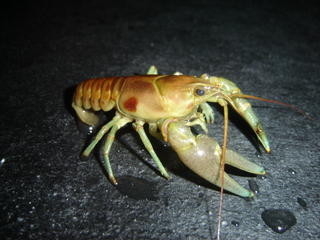Rusty Crayfish, Ashour Rehana
The Rusty Crayfish is an aggressive species of crayfish with a voracious appetite. This species of crayfish eats almost anything. Here is a list of the Rusty Crayfishes diet; small fish, fish eggs, other species of crayfish, aquatic worms, snails, leeches, fresh water molluscs, aquatic insects like mayflies, stoneflies, midges, other crustaceans, decaying plants and animals, bacteria and fungi, and live aquatic plants. The Rusty Crayfish is a serious omnivore! The metabolism of the Rusty Crayfish is much higher than our native species of crayfish which causes the Rusty Crayfish to have a much stronger appetite. When surveys were done in the Monocacy River watershed where the Rusty Crayfish was first observed, no other crayfish were caught during the study, but down river of the Rusty Crayfish population many native crayfish were observed. Of all the horrible impacts that the Rusty Cray can have on the environment, the two things that bother me the most are that they eat aquatic vegetation and they eat fresh water molluscs.
Rusty Crayfish, Ashour Rehana
Rusty Crayfish eat aquatic vegetation by pulling the plant up by its roots. This completely kills the plant. Entire stretches of streams can become plant free causing erosion and water quality to plummet. Once riverbeds are free of native aquatic plants non-native species have an easier time of taking over. Explosions of invasive plants like Eurasian Watermilfoil usually follow in the footsteps of a Rusty Crayfish introduction.
Eurasian Watermilfoil, Wiki pages
In Maryland over 70% of the native freshwater molluscs are endangered. Most of the time we can blame water pollution for our molluscs problems, but when you add an over eager, super hungry, demon crayfish to the molluscs problems they don't really stand a chance. This scares me greatly.
In June of 2007 while conducting stream surveys along Marsh Creek, a tributary of the Monocacy River, Maryland DNR discovered the first Rusty Crayfish in Maryland waters. Soon after the Marsh Creek population was discovered another population was found along Conowingo Creek in the lower Susquehanna River. Recent surveys have found them at the mouth of Antietem Creek on the Potomac River.
So, how did they get here. From everything that I have read, it sounds like the crayfish migrated south from Pennsylvania following the Monocacy River. The Susquehanna and Antietem Creek populations may have been caused by fisherman. Rusty Crayfish were once regularly used as bait. Unused bait could have been thrown overboard as a means of disposal. It is now illegal in Maryland to have Rusty Crayfish in your possession.
Range map of Rusty Crayfish, University of Minnesota
As you can see from the above map, the Rusty Crayfish is native to certain parts of the Ohio River and its tributaries, but it has spread throughout the east and even into certain portions of the western United States.
Rusty Crayfish, University of Michigan
Recognizing this alien species is really easy. Even though the Rusty Crayfish can come in many different colors (like many crayfish) there are a few distinguishing marks that make identification rather easy. Firstly, the rusty splotch just forward of the tail and above the legs on the carapace is diagnostic. Other distinguishing marks include claws that are relatively large and smooth that lack any large bumps and the tips of the claws have black bands.
Rusty Crayfish, University of Michigan
Maryland DNR asks that anyone who discovers a Rusty Crayfish to catch the animal and freeze it. Make sure you write down the exact location of where the crayfish was discovered and contact them as soon as possible. Lets hope that we can contain this invasive species and that it doesn't reek to much havoc on our sensitive freshwater streams.
I would like to thank the Universities of Michigan and Minnesota for allowing the use of photos and maps. Their websites contain lots of information that I haven't discussed that is very interesting and scary.
The military even has a website about the Rusty Crayfish's destructiveness.
Most states that have Rusty Crayfish invasions have detailed websites. Maryland's is especially informative.
Finally, I would like to thank Ashour Rehana for his great photos. His Flickr site can be viewed at





Valuable info. Thanks for sharing, Jim.
ReplyDeleteRob